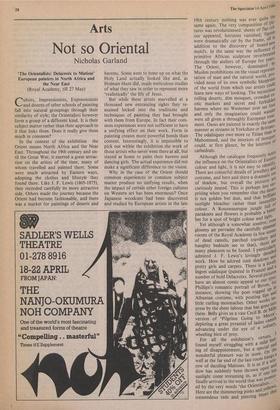Arts
Not so Oriental
Nicholas Garland
`The Orientalists: Delacroix to Matisse' European painters in North Africa and the Near East (Royal Academy, till 27 May)
Cubists, Impressionists, Expressionists and dozens of other schools of painting fall into natural groupings through their similarity of style; the Orientalists however form a group of a different kind. It is their subject matter rather than their approach to it that links them. Does it really give them much in common?
In the context of the exhibition the Orient means North Africa and the Near East. Throughout the 19th century and un- til the Great War, it exerted a great attrac- tion on the artists of the time, many of whom travelled and painted there. Some were much attracted by Eastern ways, adopting the clothes and lifestyle they found there. Like J. F. Lewis (1805-1875), they recorded carefully its more attractive side. Others made the journey because the Orient had become fashionable, and there was a market for paintings of deserts and
harems. Some went to bone up on what the Holy Land actually looked like and, as Holman Hunt did, made meticulous studies of what they saw in order to represent more `realistically' the life of Jesus.
But while these artists marvelled at a thousand new entrancing sights they re- mained locked into the traditions and techniques of painting they had brought with them from Europe. In fact their com- mon experiences were not sufficient to have a unifying effect on their work. Form in painting creates more powerful bonds than content. Interestingly, it is impossible to pick out within the exhibition the work of those artists who never went there at all, but stayed at home to paint their harems and dancing girls. The actual experience did not make a significant difference to the vision.
Why in the case of the Orient should common experiences or common subject matter produce no unifying results, when the impact of certain other foreign cultures on Western art has been enormous? Once Japanese woodcuts had been discovered and studied by European artists in the late
The Spectator 14 April 1984 19th century nothing was ever quite the same again. The very composition of Pie" tures was revolutionised: sheets of flat col- our appeared, horizons vanished, figures „5 were dramatically cut by the frame, all to to the discovery of brand-11° motifs. In the same way the influence of primitive African sculpture reverberated through the ateliers of Europe for year,s, The Orient, however, dominated °) Muslim prohibitions on the visual represen- tation of man and the natural world, Pro- vided none of its own symbolic bluer:111°,1,s of the world from which our artists Oulu learn new ways of looking. The mysterious rolling deserts, dim mosques, crowded es' otic markets and secret and forbidder: harems where no Westerner ever set f°°, and only the imagination could wallow' were all given a throughly European trot: ment. Oases are painted in exactly the Ole manner as streams in Yorkshire or Brittany The odalisques owe more to Titian than t0. Mahommed, and the interiors of mosques, could, at first glance, be the interiors °` cathedrals. Although the catalogue frequently notes
„
the influence on the Orientalists of Easleer' colour and light, it is not easy to identilci There are colourful details of jewellery costume, and here and there a dramatic use of shadow, but overall the pictures are curiously muted. This is perhaps less sur- prising when you remember that the desert, is not golden but dun, and that bril/jart' sunlight bleaches rather than intensifte5f colour. A Rousseauesque jungle full 1. parakeets and flowers is probably a bette0 bet for a spot of bright colour and ev'
Yet although a somewhat sombre, ci
gloomy air pervades the carefully digit° 5 rooms of the Royal Academy (a few seeried of dead camels, parched travellers are haughty bedouin see to that), there ar,,, many pleasures to be found. I particulaP; admired J. F. Lewis's lovingly detailed work. How he adored cool shadows 311,, pretty girls and carpets. There is a 104'; Ingres odalisque (painted in France) ancis number of bold Delacroixs. Several picture
;
have an almost comic appeal to our e/or Phillips's romantic portrait of Byron, in instance, showing the poet togged IIP„„t1 Albanian costume, with pouting lips and Albanian curling moustaches. Other works 'To' press by the sheer labour that has gone them. Belly gives us a vast Cecil B. de Mif:1111,e version of 'Pilgrims Going to Mecca's version a great pyramid of laden cattle advancing under the eye of a solitorY' wheeling bird of prey.
1 For all the exhibition's irt
found myself struggling with a valiludeisianeelt; ing of disappointment, but a speciallthe wonderful pleasure was in store. Liu a wall at the far end of the last room hang row of dazzling Matisses. It is as if a win” dow has suddenly been thrown open tads sunlight come streaming in, as if orlemis- finally arrived in the world that was Pr°- ed by the very words 'the Orientalists• Here are the shimmering pinks and Yell°that tremendous reds and piercing blues You long expected; and here at last is the strange foliage, palm leaves, exotic heat and graceful odalisque that you came to see. His emphasis on the simple and the decorative separates Matisse from those who imposed a Western imagination and technique on the exotic subjects they found. I could almost believe the whole exhibition had been contrived in order to achieve most ef- fectively this coup, which even on its own makes a visit worth while.











































 Previous page
Previous page